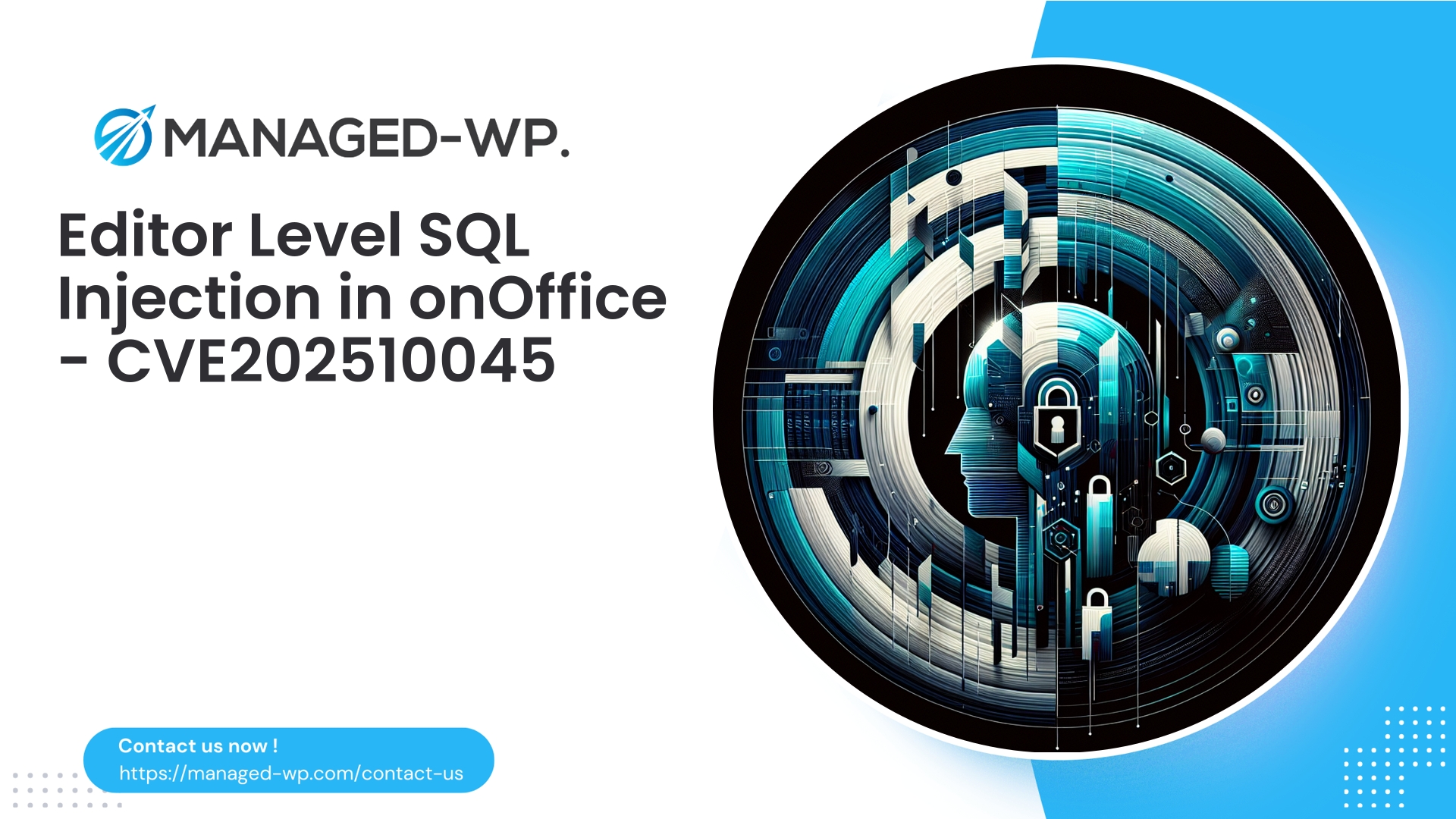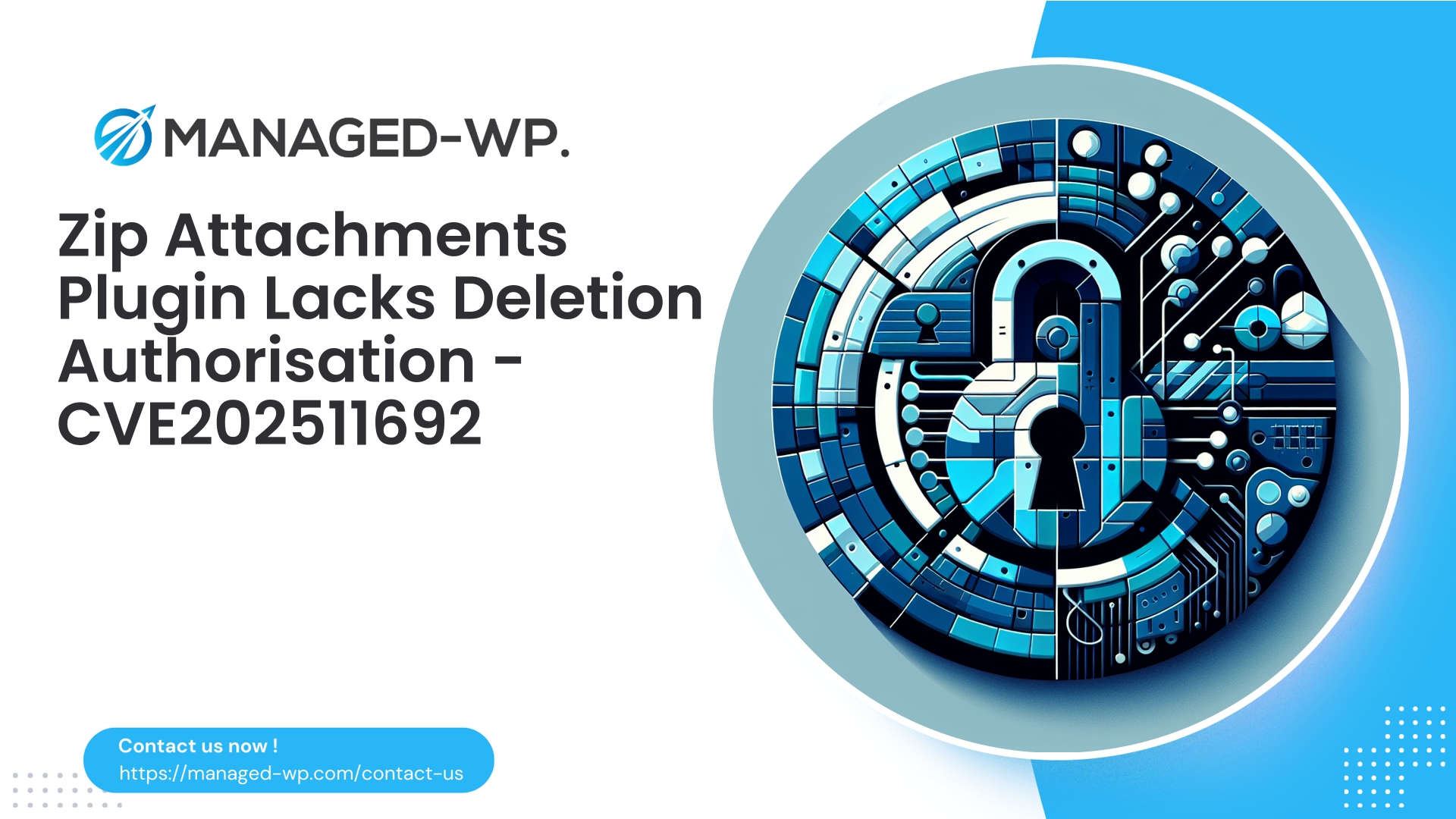| 插件名稱 | onOffice for WP-Websites |
|---|---|
| 漏洞類型 | SQL注入 |
| CVE編號 | CVE-2025-10045 |
| 緊急 | 低的 |
| CVE 發布日期 | 2025-10-15 |
| 來源網址 | CVE-2025-10045 |
onOffice for WP-Websites (≤ 5.7) — 經認證的編輯器級 SQL 注入:WordPress 網站的關鍵洞察和即時保護
發布日期: 2025年10月15日
CVE: CVE-2025-10045 — CVSS 評分:7.6(注入漏洞)
受影響的軟體: onOffice for WP-Websites 外掛程式版本 ≤ 5.7
利用該漏洞所需的權限: 編輯者(具有編輯權限的已認證使用者)
官方補丁: (截至發稿時)尚未推出
作為 WordPress 安全領域的權威機構,Managed-WP 持續監控和分析外掛漏洞,為網站所有者和管理員提供及時有效的安全情報。本安全公告針對的是 onOffice for WP-Websites 外掛程式(版本 5.7 及以下)新發現的 SQL 注入漏洞。我們將解釋此漏洞帶來的實際風險,並概述一套緊急的、循序漸進的行動方案(包括虛擬修補技術),以保護您的 WordPress 環境。
附註:本簡報專為網站所有者、開發人員和安全管理員量身打造。它刻意不涉及漏洞利用程式碼,而是專注於偵測、緩解和復原策略。
摘要(TL;DR)
- onOffice for WP-Websites 外掛程式(≤ 5.7)有 SQL 注入漏洞,任何具有編輯角色權限的已認證使用者均可利用此漏洞。
- 編輯帳號在許多 WordPress 網站上都很活躍,或者可能被攻破,使攻擊者能夠直接操縱 WordPress 資料庫,從而暴露敏感資料並修改內容。
- 儘管需要編輯等級的存取權限,CVE-2025-10045 的 CVSS 評分仍高達 7.6,這反映出其具有嚴重的潛在影響。
- 目前尚無官方補丁。可立即採取的緩解措施包括:盡可能停用該外掛程式;限制編輯角色存取權限;透過 Web 應用程式防火牆部署虛擬修補程式;並遵循下文概述的事件回應最佳實務。
- 所有安裝了 Editors 或此外掛程式的網站管理員必須立即優先採取本公告中詳述的保護措施。
為什麼編輯器層級的 SQL 注入是一個重大威脅
需要編輯權限的漏洞往往被低估,因為它們似乎無法被匿名攻擊者利用。然而,實際情況遠比這更令人擔憂:
- 編輯帳號在各種 WordPress 安裝中都很普遍——包括新聞機構、企業部落格和會員網站——並且經常成為網路釣魚和撞庫攻擊的目標。
- 編輯帳號被盜通常會成為攻擊者的跳板,他們可能會在地下論壇中取得被盜憑證。
- 編輯者可以修改貼文、頁面,有時還可以上傳媒體檔案或與敏感的管理端點互動——攻擊者可以利用這些功能植入持久後門或惡意腳本。
- 編輯器層級的 SQL 注入使攻擊者能夠直接操縱資料庫,從而可能洩露敏感的使用者資訊、重設密碼或策劃權限提升攻擊。
總之,雖然透過要求經過身份驗證的編輯器存取權限縮小了攻擊面,但這仍然是一個嚴重的安全風險,需要迅速緩解。
漏洞詳情
- 漏洞類型:已認證 SQL 注入(OWASP A1:注入)
- CVE編號:CVE-2025-10045
- 受影響版本:所有 onOffice for WP-Websites 外掛程式版本,包含 5.7 版本。
- 所需權限:已認證的編輯等級用戶
- 影響:未經授權的資料庫讀取/寫入、資料外洩、內容篡改
- 補丁狀態:目前尚無官方修復程序可用
根本原因是使用者輸入被注入到 SQL 查詢中,而沒有進行適當的參數化處理——通常是透過 AJAX 管理請求或表單處理,而這些過程中輸入清理工作不足。
為遵守負責任的揭露原則,本建議省略了概念驗證漏洞利用程式碼,但提供了以檢測、緩解和補救為重點的有力指導。
誰最該關注?
- 使用 Office for WP-Websites 外掛程式 5.7 或更早版本的網站應將此視為至關重要的優先事項。
- 擁有多個編輯帳戶的網站,尤其是那些授予媒體上傳功能或擴展內容管理權限的網站,面臨更高的風險。
- 必須仔細審查那些允許使用者註冊流程無意中將使用者提升為編輯者的網站。
- 使用此外掛程式管理多個客戶網站的託管服務提供者和代理商應將其視為普遍存在的緊急安全問題。
即使您的部署對編輯器的使用有限,任何管理員也應假定有潛在風險,直到透過全面審核確認並非如此為止。
網站所有者的即時保護措施(優先考慮)
- 庫存和評估
- 確認 onOffice for WP-Websites 外掛程式是否已安裝並處於啟動狀態。
- 檢查插件版本;如果版本為 5.7 或更早,則將其視為存在漏洞。
- 遏制
- 如果官方修補程式不可用,則停用該插件以消除漏洞利用途徑—權衡潛在的功能損失與安全風險。
- 如果停用不切實際,請使用 IP 白名單、HTTP 驗證或在 Web 應用程式防火牆中封鎖來限制對相關外掛程式端點的存取。
- 限制編輯器角色存取權限
- 審核所有編輯帳號,刪除或降級任何不必要的使用者。
- 對編輯(及其他特權)使用者強制執行立即重設密碼;實施或強制執行強密碼原則和多因素身份驗證 (MFA)。
- 使用 Web 應用防火牆 (WAF) 進行虛擬修補
- 部署 WAF 規則,以偵測並封鎖針對此外掛程式端點的 SQL 注入指標(詳細指南如下)。
- 主動監測
- 持續檢查 Web 伺服器、WordPress 活動和資料庫日誌,以發現異常情況,例如可疑的 POST 請求或意外的資料庫查詢。
- 做好事件回應準備
- 立即進行全面備份,包括資料庫轉儲和網站文件,並安全地離線儲存。
- 如果偵測到入侵跡象,則隔離受影響的站點,並執行完整的事件回應計劃,包括憑證輪替和從乾淨的備份中復原。
檢測技巧:需要注意哪些方面
分析日誌和系統行為,找出以下指標:
- Web 和應用程式日誌
- 對包含可疑 SQL 關鍵字(例如 SELECT、UNION、OR 1=1、-、/*)的插件相關 URL 發出意外的 POST 請求。
- 來自已認證編輯帳戶的重複或大量請求指向 onOffice 端點。
# Example command to find SQL injection indicators in plugin requests grep -i "onoffice" /var/log/apache2/access.log | grep -Ei "select|union|or%20|--|/\*|drop|insert" - WordPress 活動日誌
- 編輯器使用者突然或無法解釋的變更:元資料編輯、新增新的管理員使用者或異常操作失敗。
- 資料庫日誌
- 不規則或複雜的 SQL 查詢,通常不屬於外掛程式的工作量。
- 查詢中嵌入了 SQL 片段,表示存在註入嘗試。
任何可疑發現都應立即啟動封鎖和法醫調查。
臨時緩解策略(安全且可逆)
- 在發布安全性修補程式之前,請停用受影響的插件。
- 如果必須繼續操作:
- 透過 IP 過濾限制 wp-admin 存取權限,僅允許受信任的管理員存取。
- 在 wp-admin 和 wp-login.php 上實作 HTTP 基本驗證,以新增額外的驗證層。
- 透過減少編輯帳戶數量和強制執行強大的多因素身份驗證來加強存取權限。
這種分層方法顯著降低了被利用的風險。
託管WP虛擬補丁指南(WAF規則建議)
在官方修復程式發布之前,Managed-WP 強烈建議在 Web 應用程式防火牆層部署客製化的虛擬修補程式:
-
SQL注入模式阻止
偵測並封鎖針對 onOffice 外掛端點(例如,管理員 AJAX 呼叫)的查詢參數或 POST 資料中包含常見 SQLi 模式的請求。
- 如果請求 URI 引用了插件別名(例如,
操作=onoffice_*如果有效負載包含 UNION、SELECT、INFORMATION_SCHEMA、OR 1=1、-、/*、DROP 等關鍵字,則封鎖並記錄該要求。
用於識別 SQL 注入模式的正規表示式範例(請仔細測試):
(?i:union(?:\s+all)?\s+select|select\s+.*\s+from|information_schema|or\s+1\s*=\s*1|--|/\*|\bdrop\s+table\b|;) - 如果請求 URI 引用了插件別名(例如,
- 參數驗證
- 對輸入參數強制執行嚴格的類型和長度要求-阻止偏離預期數值或枚舉值的輸入。
- 非性犯罪者執法
- 要求所有資料修改型 AJAX 請求都必須提供有效的 WordPress nonce;阻止那些未經驗證的請求。
- 基於角色的請求過濾
- 限制敏感的 AJAX 操作僅限管理員等級使用者執行;阻止或記錄編輯等級帳戶對管理員保留的操作的嘗試。
- 速率限制和異常警報
- 限制對易受攻擊端點的請求速率,以防止自動化攻擊。
- 對來自相同來源的重複可疑輸入或登入異常發出警報。
- 綜合日誌記錄
- 記錄所有被阻止的嘗試及其上下文資料(不包括敏感令牌),以便進行事後分析。
Managed-WP 客戶可以啟用針對 CVE-2025-10045 的預先建置虛擬補丁簽名,或套用基於上述內容的自訂規則。
開發者指南:如何修復外掛程式碼
插件作者和開發者應遵循以下最佳實踐來解決根本原因:
-
使用參數化查詢
- 始終利用優勢
$wpdb->prepare()而不是直接將使用者輸入插入 SQL 字串中。 - 避免
sprintf()或將字串與不受信任的資料連接起來。
應避免的脆弱模式:
prefix}onoffice_table WHERE name LIKE '%$search%'"; $rows = $wpdb-> get_results($sql); ?>安全更換:
esc_like( $search ) . '%'; $sql = $wpdb->prepare( "SELECT * FROM {$wpdb->prefix}onoffice_table WHERE name LIKE %swpdb->prefix}onoffice_table WHERE name LIKE %swpdb->prefix}onoffice_table WHERE name LIKE %swp", 1 414 月); $sql ); ?> - 始終利用優勢
- 輸入驗證和清理
- 使用適當的 PHP 過濾器嚴格驗證輸入(
intval(),filter_var()). - 使用以下方式清理文字輸入:
sanitize_text_field()並且更喜歡事先準備好的報表。
- 使用適當的 PHP 過濾器嚴格驗證輸入(
- 能力檢查和隨機數字驗證
- 在進行任何資料庫修改或敏感操作之前,請確認使用者擁有相應的權限,例如:
管理選項. - 在 AJAX 和表單處理程序中實作 nonce 驗證:
<?php if ( ! isset( $_POST['my_nonce'] ) || ! wp_verify_nonce( $_POST['my_nonce'], 'onoffice_action' ) ) { wp_die( 'Invalid request' ); } ?> - 在進行任何資料庫修改或敏感操作之前,請確認使用者擁有相應的權限,例如:
- 強制執行最小權限原則
- 限制關鍵功能,使其對編輯器使用者而言,除非絕對必要,否則不應開放。
- 引入細粒度的插件級功能,實現精細的存取控制。
- 使用預編譯語句而非動態表名
- 增強日誌記錄和監控
- 新增功能故障和異常輸入(不包括敏感資料)的詳細日誌記錄。
如何偵測您的網站是否已被入侵
- 尋找異常的資料庫修改,例如:
- 未經授權的新使用者帳戶
- 使用者角色變更或意外密碼重置
- 帖子/頁面中存在可疑的內容編輯或插入鏈接
- 掃描 wp-content/uploads 或其他可寫入目錄,尋找未經授權的 PHP 檔案或 Web Shell。
- 檢查主題/外掛的最後修改時間戳記;與版本控制系統或備份進行交叉核對。
- 檢查伺服器的出站網路活動,以確定是否存在資料外洩的可能性。
- 分析資料庫日誌,尋找並非源自合法應用程式活動的奇怪 SELECT 查詢。
如果存在剝削跡象:
- 立即隔離受影響的網站(離線或流量重新導向)。
- 保留所有日誌和法醫證據。
- 輪換所有敏感憑證(WordPress 使用者、資料庫、API 金鑰)。
- 從經過驗證的乾淨備份中恢復,並在上線前應用所有緩解措施。
恢復檢查清單
- 建立全面備份(檔案、資料庫轉儲、日誌)。
- 清理期間,請將網站離線或限制存取。
- 一旦有修補程式可用,請移除或更新存在漏洞的插件。
- 進行徹底的後門和惡意軟體掃描—檢查上傳檔案和外掛目錄。
- 輪換所有與 WordPress 安裝相關的密碼和 API 金鑰。
- 請確保 WordPress 核心程式、外掛程式和主題都已更新到支援的版本。
- 重新頒發任何可能已洩漏的 SSL 憑證或 API 令牌。
- 謹慎地重新建立使用者身份,強制執行多因素身份驗證並限制權限。
- 恢復後的幾週內,需持續積極的日誌監控。
長期安全最佳實踐
- 對所有角色(尤其是編輯角色)採取嚴格的最小權限原則。
- 要求所有特權使用者啟用多因素身份驗證 (MFA) 或雙重認證 (2FA)。
- 保持外掛程式、主題和 WordPress 核心持續更新;刪除已棄用或未使用的外掛程式。
- 實施並維護具有虛擬修補功能的網路應用防火牆,以提供及時的保護。
- 定期審核外掛程式清單,並停用不再受支援的軟體。
- 使用測試環境進行外掛程式更新和安全測試;採用可靠的備份程序。
- 鼓勵插件供應商制定清晰的漏洞揭露政策,並主動監控 CVE 資訊來源。
對代理商和託管服務提供者的建議
對於管理多個 WordPress 實例的使用者:
- 使用 WP-CLI 或管理儀表板自動偵測用戶端網站上的 onOffice 外掛程式及其版本。
- 在整個叢集中部署 WAF 虛擬修補規則,以防止大規模的漏洞利用嘗試。
- 立即通知使用受影響插件的客戶,並提供清晰的修復說明。
- 優先修復有多個編輯或高價值應用程式(電子商務、會員平台)的網站。
需要監測的妥協指標
- 針對與 onOffice 關聯的管理員 AJAX 端點的包含 SQL 令牌的重複 POST 請求。
- 編輯使用者執行的異常管理活動,例如大量內容編輯或元資料修改。
- 在編輯器登入後不久,就會出現涉及連接字串、SQL 註解或 UNION 運算子的資料庫查詢。
收集並保存這些日誌,以便進行後續調查。
使用 Managed-WP Basic(免費)即可獲得即時保護
立即使用 Managed-WP Basic(免費)保護您的網站—今天就激活
為了在類似這樣的漏洞事件發生時提供直接有效的防禦,Managed-WP Basic(免費版)可免費提供必要的保護:專業管理的防火牆、無限頻寬、可設定的 Web 應用防火牆 (WAF)、自動惡意軟體掃描以及針對 OWASP Top 10 風險的全面緩解措施。我們便利的虛擬修補程式設定功能可讓您在外掛程式開發者發布官方修復程式之前阻止攻擊嘗試。立即註冊免費計劃,建立這至關重要的安全層: https://my.wp-firewall.com/buy/wp-firewall-free-plan/
(功能:託管防火牆、Web應用防火牆、無限頻寬、惡意軟體掃描器、OWASP十大安全漏洞緩解措施。進階方案包括自動惡意軟體清除、進階IP控制、每月安全報告、自動虛擬修補程式和專屬支援。)
優先摘要 — 每個 onOffice (≤ 5.7) 網站擁有者必須執行的操作
如果您的 WordPress 網站使用的是 onOffice for WP-Websites 外掛程式 5.7 或更低版本:
- 立即檢查安裝情況和插件版本。
- 如果存在安全漏洞,請盡可能立即停用該外掛程式。
- 審核所有編輯帳戶,並強制執行密碼重設和多因素身份驗證。
- 在 WAF 上實作虛擬補丁規則,以阻止外掛端點上的 SQL 注入。
- 密切監控日誌,以發現任何可疑活動。
- 官方修復程式發布後,請在測試環境中進行徹底測試並及時更新。
結語
經過驗證的 SQL 注入漏洞表明,最大的威脅往往來自被盜用或權限過高的內部帳戶,而非匿名攻擊者。立即採取果斷措施——限制編輯角色、強制執行多因素身份驗證 (MFA)、部署虛擬修補程式以及監控活動——可以顯著縮小攻擊面,並在官方修補程式發布前的這段時間內保護您的網站。
Managed-WP 隨時準備協助您全方位保護 WordPress 生態系統,從專業的防火牆管理和虛擬補丁,到持續監控和專家級事件回應諮詢,我們都能為您提供協助。如果您希望在您的產品組合中實施這些保護措施或虛擬補丁,請從我們的基礎(免費)套餐開始,並與我們的團隊聯繫: https://my.wp-firewall.com/buy/wp-firewall-free-plan/
保持警惕,記住:即使是僅限於編輯等級存取權限的漏洞,也可能為攻擊者打開可乘之機,讓他們無情地利用。



















